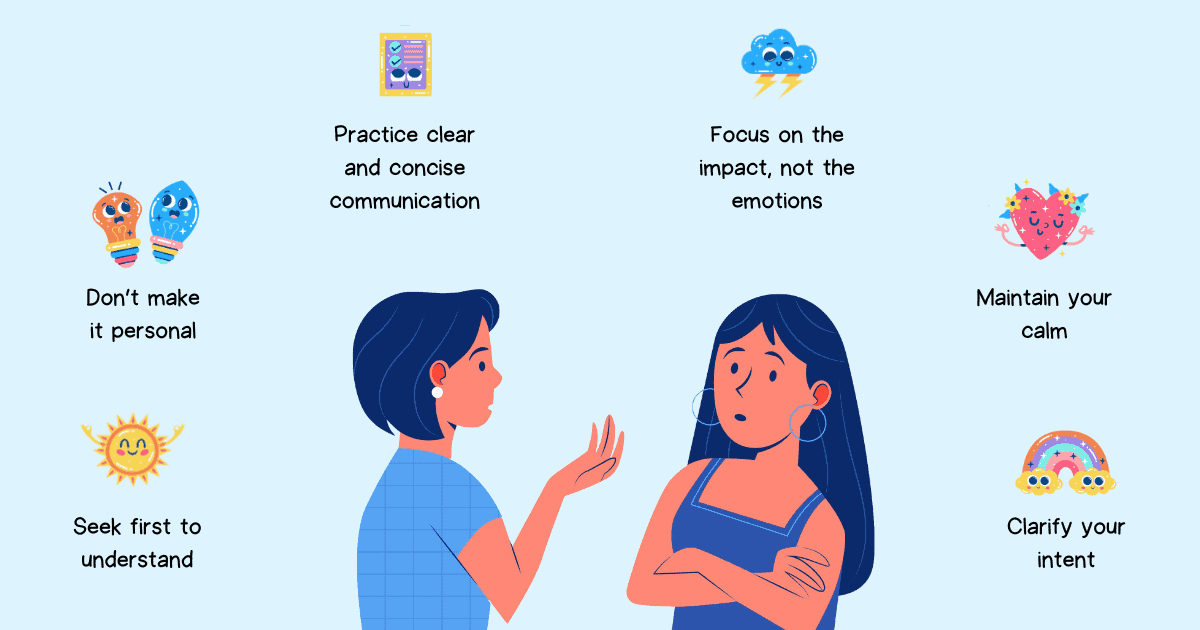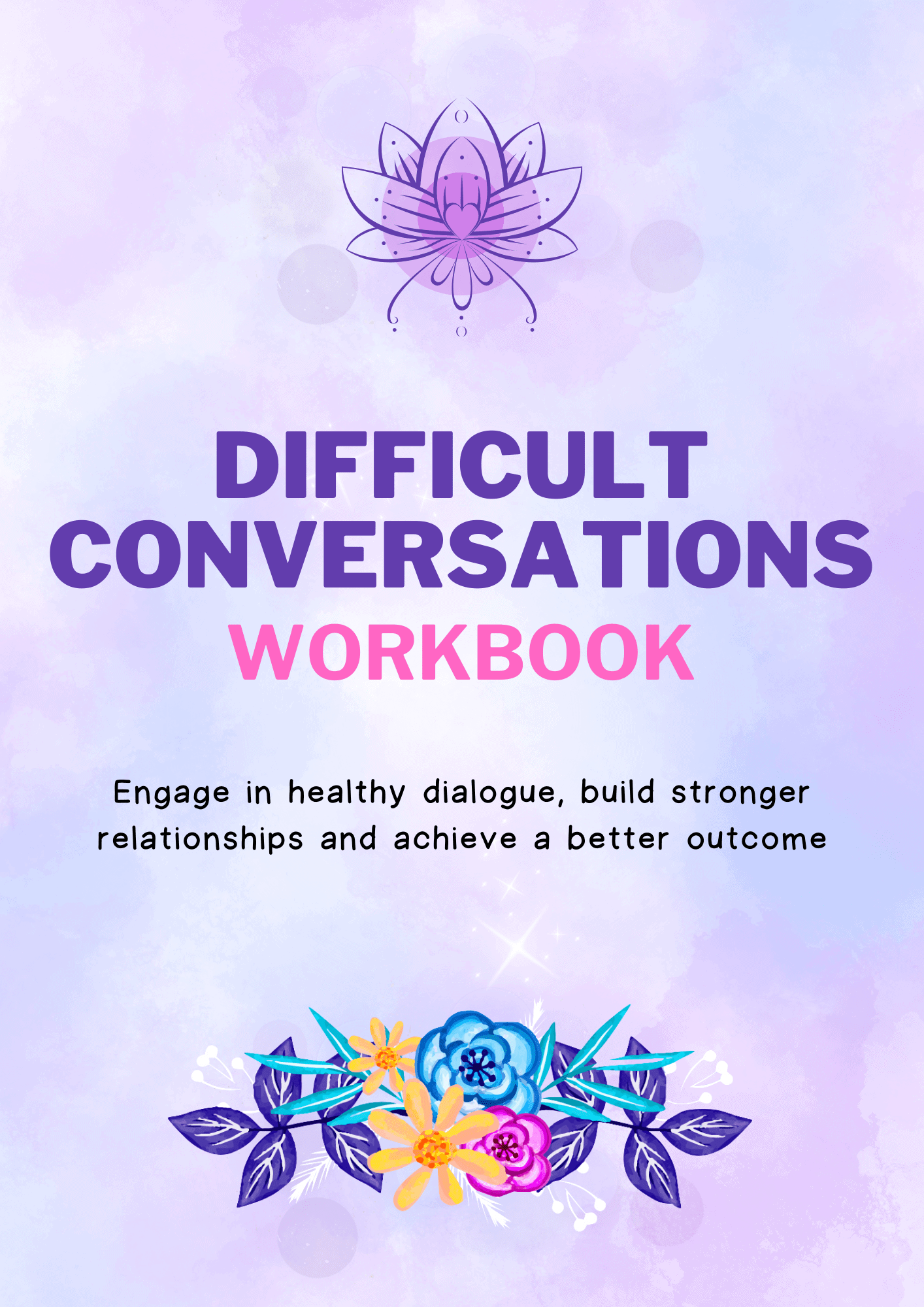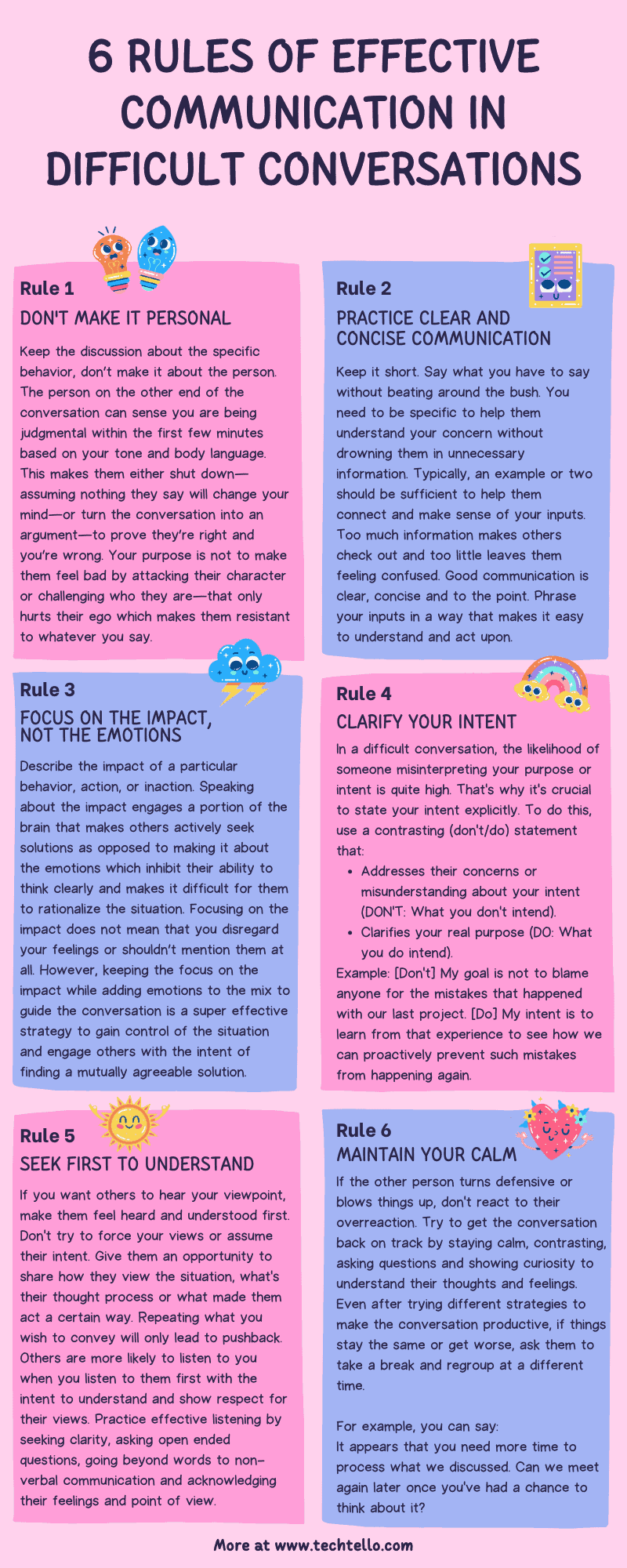6 Rules of Effective Communication in Difficult Conversations

To achieve our goals, we need to communicate well with others. But, instead of engaging in healthy dialogue right when it matters the most, we’re often at our worst behavior. We play silly and costly games — argue, attack, manipulate or act in other self-defeating ways.
Difficult conversations by nature are tricky. They are touchy topics that no one likes to talk about. They involve addressing differences of opinion, emotional issues, sensitive subjects or other potential reasons of conflict—anything we find hard to talk about.
They are challenging because they require us to navigate through discomfort, uncertainty and a wide range of complex emotions.
Beginning a conversation is an act of bravery. When you initiate a conversation, you fearlessly step into the unknown. Will the other person respond to favorably or unfavorably? Will it be a friendly or hostile exchange? There is a feeling of being on the edge. That nanosecond of space and unknowing can be intimidating. It shows your vulnerability.
— Sakyong Mipham, The Lost Art of Good Conversation
We avoid difficult conversations because it’s much easier to avoid emotionally draining and mentally exhausting situations than step right into them consciously.
But putting off difficult conversation is a bad idea because:
- Issues left unaddressed escalate over time. What was once a manageable problem can grow into a much larger issue if not addressed on time.
- Constant worry about unresolved issues can take a toll on your mental health and lead to increased stress, anxiety and even feelings of helplessness.
- When important issues are being ignored or swept under the rug, it can erode trust, build resentment and damage relationships.
No matter how hard a conversation is, you can’t put it off or delay it forever. Addressing issues directly, providing clarity and seeking closure can help you gain trust, respect and also alleviate stress.
But to handle difficult conversations well, you need to follow good communication practices. Here are the six rules of effective communication in a tough conversation:
Rule 1: Don’t make it personal
Keep the discussion about the specific behavior, don’t make it about the person. The person on the other end of the conversation can sense you are being judgmental within the first few minutes based on your tone and body language. This makes them either shut down—assuming nothing they say will change your mind—or turn the conversation into an argument—to prove they’re right and you’re wrong.
Your purpose is not to make them feel bad by attacking their character or challenging who they are—that only hurts their ego which makes them resistant to whatever you say.
For example:
Instead of: You’re dominating.
Say this: When you interrupt others and don’t let them speak, it makes them think that you don’t care about their opinion.
Instead of: You’re rude.
Say this: When you speak to others in a loud voice or show your anger, you lose trust and respect.
Instead of: You’re dumb.
Say this: I understand that some things may be difficult for you. But you’ve to ask questions or seek clarifications when you don’t get them. We have discussed this requirement multiple times and every time I get the feeling that you’ve understood it well, but then a few days later we are back to square one.
The first statement will immediately put the other person on the defensive while the second one gives them an opportunity to engage in a constructive dialogue.
Respect is like air. As long as it’s present, nobody thinks about it. But if you take it away, it’s all that people can think about. The instant people perceive disrespect in a conversation, the interaction is no longer about the original purpose—it is now about defending dignity.
— Ron McMillan, Crucial Conversations
Master Difficult Conversations
Engage in healthy dialogue, build stronger relationships and achieve a better outcome.
Rule 2: Practice clear and concise communication
Keep it short. Say what you have to say without beating around the bush. You need to be specific to help them understand your concern without drowning them in unnecessary information. Typically, an example or two should be sufficient to help them connect and make sense of your inputs.
For example:
Situation: Your manager has a tendency to call late in the night which disturbs evening time with your family.
Don’t: Blabber about it or expect them to read between the lines without explicitly stating your concern.
Do: Tell them that their calls in the night make it difficult for you to spend quality time with your family and why you need that downtime to make a productive contribution at work.
Situation: Your team member has the habit of disregarding others’ ideas and opinions.
Don’t: Share general advice on seeking diverse viewpoints or encouraging more participation from others in discussions. They’re most likely to ignore it.
Do: Share examples from previous discussions or meetings where they ignored others’ inputs. Ask them how they can be more inclusive going forward.
Situation: You’re passed up for a great opportunity you think you deserved.
Don’t: Complain to your manager about their decision or show resentment for not getting what you wanted.
Do: Express your disappointment, but show respect for their decision. Try to understand what you lacked and how you can cover up those gaps to get such opportunities next time around.
If you want to appear more confident—speak slowly, articulately, clearly, and deliberately. Communicating with clarity will not only help you build more confidence in yourself, but it will inspire respect from others.
— Susan C. Young, The Art of Being
Rule 3: Focus on the impact, not the emotions
Describe the impact of a particular behavior, action, or inaction. Speaking about the impact engages a portion of the brain that makes others actively seek solutions as opposed to making it about the emotions which inhibit their ability to think clearly and makes it difficult for them to rationalize the situation.
For example:
- If a coworker has the habit of using offensive language at work, instead of expressing your disgust, tell them how it impacts your collaboration.
- If your manager keeps canceling your one-on-one meeting, instead of showing your frustration, explain why not having such discussions limits your growth.
- If a team member tries to take credit for your ideas, instead of being annoyed, make it clear that you’ll stop sharing your ideas with them if they continue to behave this way.
Focusing on the impact does not mean that you disregard your feelings or shouldn’t mention them at all. However, keeping the focus on the impact while adding emotions to the mix to guide the conversation is a super effective strategy to gain control of the situation and engage others with the intent of finding a mutually agreeable solution.
Rule 4: Clarify your intent
In a difficult conversation, the likelihood of someone misinterpreting your purpose or intent is quite high. That’s why it’s crucial to state your intent explicitly. To do this, use a contrasting statement.
A contrasting statement is a don’t/do statement that:
- Addresses their concerns or misunderstanding about your intent (DON’T: What you don’t intend).
- Clarifies your real purpose (DO: What you do intend).
For example:
[Don’t] I am not trying to say that your idea isn’t worth discussing. I think many of the points you have raised are extremely valuable.
[Do] However, I want to ensure that we also consider other alternatives before making a decision.
[Don’t] It’s not that I don’t value your work or the effort you’ve put into this proposal. I can see that your research is extensive and covers all major areas.
[Do] However, I think it will be useful to take the recent shift in org strategy into consideration and re-evaluate this proposal.
[Don’t] My goal is not to blame anyone for the mistakes that happened with our last project.
[Do] My intent is to learn from that experience to see how we can proactively prevent such mistakes from happening again.
Intention is one of the most powerful forces there is. What you mean when you do a thing will always determine the outcome.
— Brenna Yovanoff
Rule 5: Seek first to understand, then to be understood
If you want others to hear your viewpoint, make them feel heard and understood first. Don’t try to force your views or assume their intent. Give them an opportunity to share how they view the situation, what’s their thought process or what made them act a certain way.
Repeating what you wish to convey will only lead to pushback. Others are more likely to listen to you when you listen to them first with the intent to understand and show respect for their views.
Practice effective listening:
- Seek clarity and invite them to talk by asking open ended questions.
- “Tell me more…”
- “Help me understand …”
- “Describe it to me …”
- “What do you think about …”
- “I would like to understand where you are coming from …”
- “Can you share a little more about how you see things …?”
- Go beyond the words to the non-verbal communication—tone of voice, hand gestures and body language.
- Don’t interrupt or get defensive to get your message across. Share what you wish to convey by speaking up when they’re done.
- Don’t try to hog the spotlight. The conversation is not about you.
- Acknowledge their feelings and point of view. Acknowledging does not mean that you agree with them. It simply means that you understand how they feel.
- “From what you’ve told me, I understand that you feel overwhelmed.”
- “I see you are getting really stressed by this.”
- “If I’m understanding you correctly, you are mad right now for ….”
- Discuss what’s relevant to the current conversation. Stay on track. Avoid going off-topic.
Move from Certainty to Curiosity. There’s only one way to come to understand the other person’s story, and that’s by being curious. Instead of asking yourself, “How can they think that?!” ask yourself, “I wonder what information they have that I don’t?” Instead of asking, “How can they be so irrational?” ask, “How might they see the world such that their view makes sense?” Certainty locks us out of their story; curiosity lets us in.
— Douglas Stone, Difficult Conversations
Rule 6: Maintain your calm
If the other person turns defensive or blows things up, don’t react to their overreaction. Try to get the conversation back on track by staying calm, contrasting, asking questions and showing curiosity to understand their thoughts and feelings.
Even after trying different strategies to make the conversation productive, if things stay the same or get worse, ask them to take a break and regroup at a different time.
For example, you can say:
- It appears that you need more time to process what we discussed. Can we meet again later once you’ve had a chance to think about it?
- Will it be helpful if you get some time to think about what we discussed? We can always meet later again.
Getting angry at others for overreacting or not processing the information the way you expected will only make matters worse. Give them space and time to address your concerns.
Summary
- Difficult conversations though necessary are hard to crack. Fear of a bad outcome or not knowing what to say can prevent you from engaging in meaningful dialogue right when you need it the most.
- Left unhandled, conflicts tend to get worse. The more you avoid or put off difficult conversation, the harder it is to tackle later.
- When you attack a person’s character or pass strong judgment about who they’re, they are bound to react badly and turn defensive. Instead of a personal attack, address specific behaviors or actions that concern you.
- Too much information makes others check out and too little leaves them feeling confused. Good communication is clear, concise and to the point. Phrase your inputs in a way that makes it easy to understand and act upon.
- Emotions while healthy to express shouldn’t be your only weapon. Stating the impact is crucial because it engages the thinking part of the brain necessary to solve problems and agree on common solutions.
- A good intent in a difficult conversation is not enough, you need to explicitly express it. Once others are aligned with your purpose, it’s easier to have a healthy discussion and seek closure.
- We think difficult conversations are about sharing our views, stating our expectations and expressing our dissatisfaction. But in doing all the talking, we forget a crucial aspect of good communication—hearing others’ viewpoints and respecting their opinion.
- Finally, some difficult conversations can turn violent or aggressive. Losing your calm in such moments can turn a bad situation into worse. Diffuse the tension by asking others to connect at a later date.






























